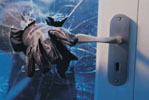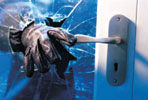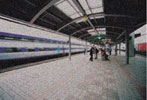
Understanding the terms and features of CCTV equipment is essential in getting the optimal results from equipment for different applications...
2D peaking
2D peaking filters enhance video image sharpness, which in turn results in outstanding image quality.


Response time of 8 ms
A response time of 8 ms eliminates dragging and after-images on screen.


High brightness (300 cd/m²)
Brightness of 300 candelas per square metre (cd/m²) will ensure a clearer image.


Dynamic CCD defect correction function
There are two types of defect correction methods, namely static correction and dynamic correction. The static correction method rectifies defects with the lens iris fully closed. This is adjusted only once at the factory, prior to shipment. The dynamic correction method detects and rectifies defects each time they occur, regardless of the opening of the lens iris.


Colour transient improvement (CTI)
Colour transient improvement (CTI) smoothes out the edges of the colour images so that they are more distinct and colours are more precisely reproduced.


WDR (wide dynamic range)
WDR is a sophisticated version of BLC (back light compensation). It is able to show two files in one complex image by utilising high shutter speed in bright areas and low shutter speed in dark areas. When the camera detects an obvious difference in luminance, rather than showing the whole viewing area at one luminance level, it increases the range of the luminance so that there is no noticeable difference.


Day and night
The day and night function employs intelligent technology that allows for automatic switching to colour mode during the day and to black and white mode at night. It is ideally suited for 24/7 surveillance depending on the level of illumination on site.


DNR (digital noise reduction)
The digital noise reduction (DNR) function removes ‘noise’ that commonly occurs in video signals, particularly when automatic gain control (AGC) is used in low-light conditions. It is generally performed using camera memory, which means that when an object moves, the image can be blurred. However, the DNR function in Elvey’s cameras uses a special Samsung computer code, which renders it impervious to the motion of an object and allows for the provision of clear images.


Motion detection
When movement is detected in a specified monitoring area, the camera will trigger an alarm. External alarm devices attached to the cameras allow users to check screens for alarm alerts. This function is useful when users are tasked with monitoring multiple screens at the same time.


Illumination
By converting the speed of the light entering a designated area, an object can be accurately detected even in low illumination. The minimum low illumination of the 0,00009 Lux allows for more vivid image capture with far greater performance than traditional cameras.


Low minimum illumination of 0,0002 Lux
By converting the speed of light entering into each area, an object can be accurately detected even in low illumination. The minimum low illumination of 0,0002 Lux allows capturing of much more vivid images with performance far greater than typical cameras.


3D noise reduction (NR)
3D noise reduction removes noise from analogue video signals and eliminates image flicker, thereby producing a far clearer image.


DCDi (directional correlational deinterlacing)
DCDi can send interlaced video signals corresponding to the conventional analogue broadcasting method and can save them in the form of a file. DCDi provides sharp noiseless images for video with high movement by compressing the moving images and converting them into progressive video after digitally processing the noise generated by the time difference between fields.


DIS (digital image stabiliser)
Image-shake caused by an unstable camera can be corrected using this technology, thereby producing crisper images.


Zooming
Up to 320x magnification means far easier object identification. This is performed through a combination of a 32x optical zoom and 10x digital zoom.



© Technews Publishing (Pty) Ltd. | All Rights Reserved.